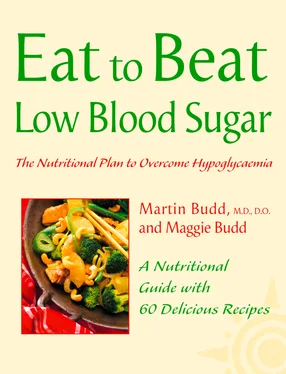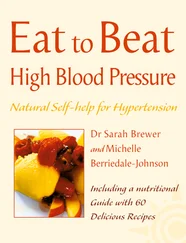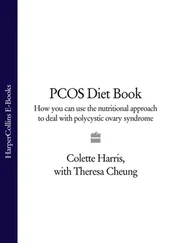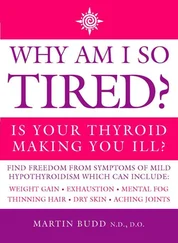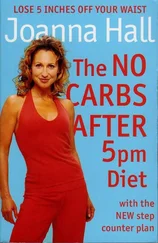Fatigue at the end of the day may be caused by overwork, anaemia or a variety of ailments. Fatigue on rising, which improves towards the end of the day, offers a strong clue to the possible diagnosis of low blood sugar. A subjective evaluation is never easy, for unless one is familiar with the diagnostic value of symptom patterns, it is very difficult to diagnose one’s own problems.
One of the chief characteristics of low blood sugar sufferers is the combination of physical and mental symptoms coupled with considerable variation in the symptoms. Sometimes the patient may feel on top of the world; at other times he or she may feel exhausted and depressed for no apparent reason. Remember, we are not dealing with a predictable organic disease such as arthritis or anaemia, but an imbalance in the nervous, circulatory, digestive and endocrine systems. Therefore any symptoms may be the expression of a great number of interrelating and fluctuating causes. These causes can include diet, emotional state, menstruation, time of day, stress, fatigue, the side effects of drugs and many other factors.
No illness suddenly arrives. There are always changes in the body before the symptoms become apparent to the patient. With low blood sugar the early symptoms are usually vague and difficult to identify. The commonest symptoms are fatigue associated with a dulling of concentration, irritability and mild anxiety or depression, feeling thick-headed on waking and a distinct loss of zest before mid-morning.
Early symptoms may also include transitory feelings of panic or breathlessness with cold sweating and headaches, often accompanied by a craving for something sweet. Such symptoms are often diagnosed as being due to overwork, stress or just ‘nerves’. The usual sedatives and relaxants are prescribed, but if symptoms are caused by low blood sugar, any relief will be only temporary. The fatigue will still be there, often without excessive effort or work, and the anxiety will persist, despite a lack of stress.
It is unfortunate that many people with low blood sugar suffer their symptoms because of a false diagnosis. Often they are classified by doctors and family as neurotic when, in fact, the cause of their symptoms is physiological and not psychological.
When looking into a person’s history, disorders often feature that provide clues to future low blood sugar. These include hepatitis, jaundice, morning sickness during pregnancy, biliousness and intolerance of fats, a history of gall bladder trouble, chronic fatigue and overweight. The role of the body’s early warning system is to indicate the development of a biochemical imbalance or damage of some kind. If the early symptoms of low blood sugar are accurately diagnosed before the obesity, fatigue, migraines and diabetes develop, a great deal of pain and distress may be avoided.
Faulty nutrition is the single most important cause of low blood sugar. The modern Western diet, with its high sugar content, refined starches, artificial additives and low nutritional value, provides an appropriate formula for causing blood sugar imbalances. If we also consider the modern habits of snack meals, frequent coffees and the excessive use of drugs, alcohol, cola drinks and tobacco, it is no surprise that the incidence of high and low blood sugar conditions is increasing at an alarming rate.
As poor diet is a key factor in the development and maintenance of low blood sugar, it is obviously an important clue in the diagnosis of the problem. I find in practice that most low blood sugar sufferers have characteristic dietary habits that provide important leads to the cause of their symptoms. It must be remembered that, for these patients, meals are not simply a question of choice, for the pattern of meals and type of food is strongly influenced by the underlying low blood sugar. Sugary foods and drinks and caffeine-rich or alcohol-rich drinks all provide temporary relief to the symptoms of low blood sugar. Not surprisingly, the diet reflects this and is usually high in these items and in particular there may be cravings for sweet foods far in excess of normal consumption. One of the most significant clues is a person’s sugar intake – two to three teaspoonfuls in either tea of coffee is not unusual. Smoking can also be a clue, as many tobacco addicts experience low blood sugar symptoms.
Because our blood sugar is linked to the appetite, a frequent symptom is hunger. This is not a general feeling of hunger, but more often a craving for a certain type of food. However, the low blood sugar patient, because of the symptoms produced by his condition, often cannot face food. This usually occurs at breakfast time as the blood sugar drops overnight. The thought of breakfast can make a person with low blood sugar feel physically sick. Usually a coffee or cigarette starts the day, and the inevitable ‘high’ provided by the caffeine produces a mid-morning ‘low’ as the blood sugar drops again. So the day consists of small frequent ‘shots’ of sugar or caffeine to maintain the energy level and the concentration at a tolerable level.
When the blood sugar has sunk to a low level, usually around 3–5am, the low blood sugar sufferer often wakes with stomach cramp, indigestion or just hunger – for this reason they are often night nibblers.
The two diets listed below are those of two patients seen in my practice. Every characteristic of the typical eating habits associated with low blood sugar can be seen here.
Example 1
Breakfast: Cereal with sugar and milk, 4–5 cups of tea with 1 teaspoonful of sugar in each cup
11 am: Tea with a biscuit or cake
Lunch: Sandwich with tea and biscuit
4pm: Cake with tea
Dinner: Meat and vegetables with sweet dessert, cup of tea
Supper: Crackers, cheese, biscuits and tea
Tea: 12–14 cups daily
Coffee: rarely
Cigarettes: 20–30 a day
Sweets and chocolate: 100–175g (4–6oz) a day
Alcohol: 20–25 units weekly
Example 2
Breakfast: 2 coffees with 2 1/2 teaspoonfuls of sugar in each
11am: Coffee with biscuits
Lunch: Toast with egg or cheese, 2 coffees
4.30pm: Cake with coffee
Dinner: Meat and vegetables followed by coffee
Supper: Cake with coffee
Tea: nil
Coffee: 8–10 cups daily
Cigarettes: 10–12 a day
Sweets and chocolate: 50g (2oz) a day
Alcohol: 15–18 units weekly
There is only one physical sign linked to low blood sugar – a tenderness over the pancreas in the left upper quadrant of the abdomen, often extending as low as the umbilicus. This tenderness is felt just below the ribs, or at times round the side of the ribcage. It is caused by pancreatic sensitivity due to hyperinsulinism. (The functions of the pancreas include the secretion of various substances including insulin to lower blood sugar, and glucogon to raise the blood sugar.) In practice, I find that if I press most patients’ abdomens hard enough they are tender in most places. It is important therefore to press with the same gentle pressure all over the stomach, liver and pancreas areas – and then ask the patient, ‘which is the most tender?’ The fingers encounter a feeling of tightness, or even hardness, accompanying the discomfort. This sign usually disappears as treatment progresses and provides confirmation that the situation is normalizing.
Although the patient’s weight, colouring, blood pressure and so on are all significant in low blood sugar, they are all influenced by many other disorders and are therefore not of special value in diagnosing low blood sugar.
The six-hour glucose tolerance test (GTT)
Читать дальше
